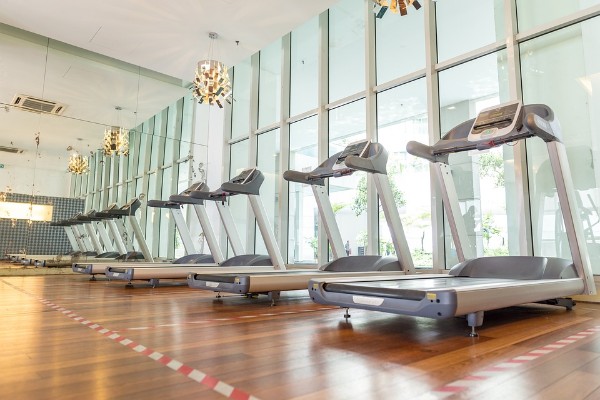Backwards treadmill walk is a common technique used in physical therapy clinics to help patients improve their gait and mobility in their lower extremities. It is frequently used to increase lower extremity strength, range of motion, and lower extremity mechanics related to gait.
But how safe is walking backwards, and how helpful is it? Here is all there is to know about backward walking and how to incorporate it into your treadmill routine.
Benefits of Backwards Treadmill Walk
Improves Gait And Mobility
In comparison to forward walking, backward walking can increase your mobility in the knees, hips, and ankles as well as reduce pain and shock. Reverse walking may occasionally be used by physical therapists to enhance gait following an illness, surgery, or injury.
It can hurt to toe-off when walking normally, especially if you have an ankle injury. Walking backward can help to “reset” your gait, improving your ability to walk forwards.
The inability to straighten out the knee is a common deficit following knee injuries or surgeries like ACL construction. Your range of motion may be improved by walking backward, which naturally straightens the knee joint.
Boosts Heart Rate And Calorie Burn
You can exert more effort while exercising by walking backwards. It can increase your heart rate, according to one study. Furthermore, it’s known to burn more calories than forward-moving walking.
According to the ACSM Compendium of Physical Activities, a brisk walk at 3.5 miles per hour can produce 4.3 METs (metabolic equivalents), while walking backward at the same speed generates 6.0 Mets. This represents an increase in calorie burn per minute of 60 percent.
This makes walking backwards the best exercise you can do to intensify your workout. Furthermore, you’ll increase your calorie burn even if you walk more slowly when going backward. The next time you want to level up, try walking backward instead of increasing the speed or incline.
Improves Quad Function
The quadriceps muscles also referred to as your upper thighs, may perform better when you reverse walk. Your quadriceps play a crucial role in bending your knee, so tightness or weakness there can result in knee pain. Leg extensions and other leg-straightening exercises, as well as walking backward, target the quads.
Your quad muscles are working as you move from toe to heel and straighten your knee as you walk backward. You can get used to walking backward, which can feel awkward at first, by moving slowly while moving at a pace of 0.5 to 1.0 miles per hour. Keep your quads engaged throughout each step.
Builds Strength And Stability
Walking backward strengthens muscles other than your quads and can help to strengthen the muscles around your ankle joint, such as the small muscles in your foot, calves, and shins.
This practical strength can improve your stability and balance and is particularly beneficial in real-world situations like jogging on uneven sidewalks or running workouts when you’re picking up the pace.
Increase Knee Range Of Motion
Reverse walking might increase the range of motion in the knee during extension. You may lose knee extension—your knee’s capacity to straighten—if you have a knee injury, knee surgery, or knee arthritis.
You shift from your toes onto your heel as you walk backward, allowing your bent knee to fully straighten. The range of motion for knee extension is enhanced as a result.
Improved Heart And Lung Function
Your heart and lungs can benefit from using a treadmill while walking backwards. Walking backwards is harder than walking forward and requires more effort.
It demands more of the cardiovascular system and requires more oxygen, according to studies in healthy subjects.5 As a result, it enhances heart and lung health more than forward walking.

Walking Backward Vs. Forward
Walking backwards has some significant differences from walking forward. There are specific movements that are regarded as typical gait characteristics when you walk forward. The heel of your leg descends to the ground first as it swings through the air.
Then, as you roll from your heel to your toes, your straight knee will slightly bend. Your opposite leg then rolls up into the air from your toes as this happens. Normal walking resumes after this heel-to-toe movement.
An opposing gait pattern is used when walking backwards. Your knee bends as your leg swings through the air and reaches behind you. You roll from your toes to your heel, making contact with the ground as your bent knee straightens.
The process is then repeated as you lift your heel off the ground while keeping your knee straight. The advantages of this toe-to-heel gait pattern are likely to be numerous.
How To Walk Backwards On A Treadmill
It’s important to check with a PT to make sure backward treadmill walking is safe for you if you have an injury or pain before giving it a try.
Once you’ve been given the all-clear, begin slowly to find your rhythm. You may discover that simply moving backward at a slow pace is enough of a challenge to begin because backward walking will put your balance and coordination to the test.
As you get the hang of it, you can gradually speed up. Depending on your comfort level, it might take several sessions to work your way up, or more athletic people might feel ready to crank it up right away. Play it safe and pay attention to your body.
To safely walk backwards on the treadmill:
- With your feet on either side of the belt, stand on a treadmill while facing the back of the device.
- Put the safety clip in place. In order to reduce your risk of falling, the belt will automatically stop if you stray too far from the treadmill’s front.
- Run the treadmill at its slowest speed before starting it.
- Hold on to the treadmill’s handrails.
- Step onto the treadmill, reach one leg back, and step forward, landing on your toes. Your knee will straighten as it comes under you naturally, so roll onto your heel.
- To increase the speed as you become more comfortable, either do it yourself or, better yet, ask a friend, trainer, or physical therapist to do it for you.
How Long To Walk Backwards On A Treadmill
Your goal will ultimately determine how long your workout is. If recovery from an injury or surgery is your main goal, we advise beginning with slow, one-minute intervals that concentrate on improving strength, coordination, and mobility. Build up to small increases in speed or time as you are able. Start small.
It is sufficient to perform a few brief intervals one to two days a week if you are walking backward to maintain the health of your knees and ankles. Try adding it toward the end of your exercise session and keep your pace slow to concentrate on muscle activation (as opposed to speed where the form may start to deteriorate).
Reverse walking for longer durations of five to 20 minutes will help increase your heart rate and burn more calories if you want to push the intensity.
Close Note
Backwards treadmill walk reverse walking on the treadmill is occasionally used to help people increase their range of motion, flexibility, or strength while walking. Your physical therapist might have you walk backward to speed up your recovery if you have a lower extremity injury. You might be able to quickly and safely regain your maximum level of mobility and function if you know what to anticipate from reverse walking.
FAQ
Does Walking Backwards On A Treadmill Do Anything?
There are numerous advantages to running backwards or even walking backwards on a treadmill. It helps to improve your balance in addition to toning various muscles. It even raises your heart rate, making it a good variation on an interval workout.
What Muscles Does Walking Backwards On A Treadmill Work?
Particularly, when walking backwards on a treadmill (especially one inclined), you heavily recruit your calves and quadriceps muscles. As with any treadmill exercise, walking the hands off the side rails is ideal for achieving the best results.
What Does Walking Backwards Do To The Brain?
Reversing direction may aid short-term memory, according to a study. Instead of retracing your steps after losing your car keys, you might want to try walking backward to help you remember.
